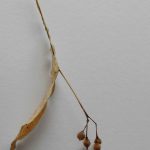
When you step outside the FSM office right now, you’ll likely notice the sweet scent of the bee tree wafting on the breeze. There are quite a few bee trees, more commonly known as linden or basswood, in our downtown Bangor neighborhood. They’ve grown tall enough to shade the sidewalks and grace us with their pleasant scent for a week or so each summer. Clusters of whitish-yellow blossoms, five petals each with a pale green bract, cover the trees and will eventually produce little pea-sized nutlets. The blossoms are attractive to bees, which produce a particularly flavorful honey from its nectar.
In the wild Tilia americana can be found on rich sloping sites with good soil and moisture, often forming stands with sugar maples. The decaying trunks make excellent nest cavities for pileated woodpeckers, wood ducks, and other woodland species. Lightweight, highly workable, and fine-grained the wood is popular with woodcarvers as well.

Roughly 8 weeks later…

The delicate flowers that covered the linden trees, sweetly scenting the air, have turned into tiny brown nutlets. These little roundish fruits/seeds have short hairs that give them a slightly fuzzy look. The clusters of fruits have replaced the numerous summer blossoms while the bracts (a modified/specialized leaf) are turning from a pale green to a soft yellowy-brown color as the fruit ripens. These seeds will be eaten by birds and small mammals and during the lean winter months the buds provide good browse for hungry birds and deer.
Fun fact: Several parts of the linden, namely flowers, leaves, bark, and wood, have medicinal uses for treating ailments such as coughs, headaches, muscle spasms, edema, and many other disorders. The young leaves and buds are considered edible, although we can’t vouch for their tastiness.

